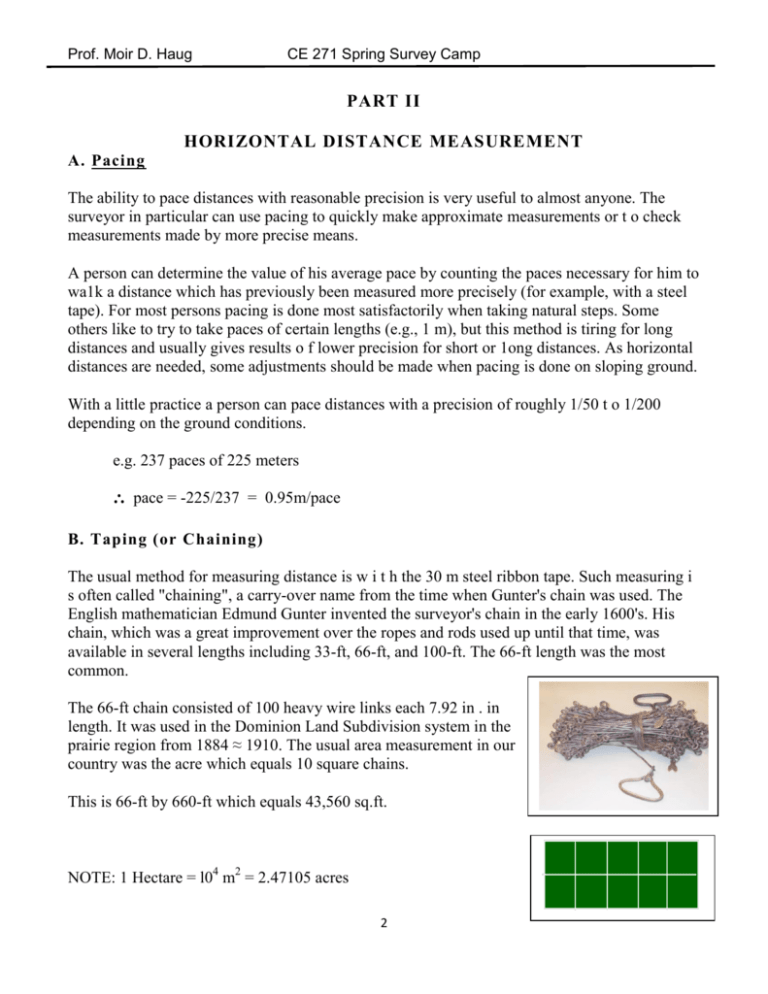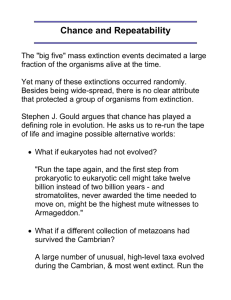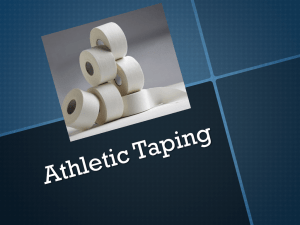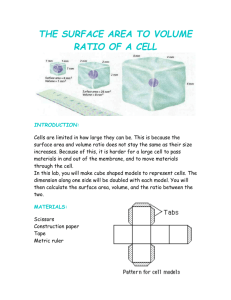
Prof. Moir D. Haug
CE 271 Spring Survey Camp
PART II
HORIZONTAL DISTANCE MEASUREMENT
A. Pacing
The ability to pace distances with reasonable precision is very useful to almost anyone. The
surveyor in particular can use pacing to quickly make approximate measurements or t o check
measurements made by more precise means.
A person can determine the value of his average pace by counting the paces necessary for him to
wa1k a distance which has previously been measured more precisely (for example, with a steel
tape). For most persons pacing is done most satisfactorily when taking natural steps. Some
others like to try to take paces of certain lengths (e.g., 1 m), but this method is tiring for long
distances and usually gives results o f lower precision for short or 1ong distances. As horizontal
distances are needed, some adjustments should be made when pacing is done on sloping ground.
With a little practice a person can pace distances with a precision of roughly 1/50 t o 1/200
depending on the ground conditions.
e.g. 237 paces of 225 meters
∴
pace = -225/237 = 0.95m/pace
B. Taping (or Chaining)
The usual method for measuring distance is w i t h the 30 m steel ribbon tape. Such measuring i
s often called "chaining", a carry-over name from the time when Gunter's chain was used. The
English mathematician Edmund Gunter invented the surveyor's chain in the early 1600's. His
chain, which was a great improvement over the ropes and rods used up until that time, was
available in several lengths including 33-ft, 66-ft, and 100-ft. The 66-ft length was the most
common.
The 66-ft chain consisted of 100 heavy wire links each 7.92 in . in
length. It was used in the Dominion Land Subdivision system in the
prairie region from 1884 ≈ 1910. The usual area measurement in our
country was the acre which equals 10 square chains.
This is 66-ft by 660-ft which equals 43,560 sq.ft.
NOTE: 1 Hectare = l04 m2 = 2.47105 acres
2
Prof. Moir D. Haug
CE 271 Spring Survey Camp
Steel tapes are most commonly 30 m long, approx. 8 mm wide, 0.6 mm thick, and weigh 1 or 2
Kg. They are either carried on a reel or done up in 2-m lengths to form a figure 8 from which
they are "thrown" into a convenient circle. These tapes are very strong as long as they are kept
straight but if they are tightened when they have loops or kinks in them, they will break very
easily. English tapes are marked at the one foot points from O to 100 ft. Older tapes had the last
foot at each end divided into tenths of a foot, but the newer tapes have an extra foot beyond 0
which is subdivided. Several variations are available, for example, tapes divided into feet, tenths
and hundredths for their entire length.
Metric tapes are available in lengths of 30, 50 and 100 meters. The newer styles of tape are
made out of nylon coated woven steel ribbon and most are divided into meters and millimeters
for their entire length.
C. Range Poles
Range poles are used for sighting points and for l i n i n g up tape-persons in order to keep them
going in the right direction.
D. Plumb Bobs
Plumb Bobs for surveying are made of bronze and weigh from 8 to 16 oz . They have sharp
replaceable points and a device at the top to which the plumb bob strings may be tied.
E. Taping Pins
Taping pins are used for marking the ends of tapes at intermediate points while taping.
F. Taping Over Level Ground
If taping is done on fairly smooth and level ground where there is little underbrush, the tape can
be held on the ground. The taping party consists of the head tapeperson and the rear tapeperson.
The head tapeperson leaves one taping pin with the rear tapeperson for counting purposes and
perhaps to mark the starting point. The head tapeperson takes the zero end o f the tape and walks
down the line toward the other end.
When the 30 m end of the tape reaches the rear tapeperson, the rear tapeperson calls "tape" or
"chain" t o stop the head tapeperson, The rear tapeperson holds the 30 m mark at the starting
point and aligns the head tapeperson (using hand signals) on the range pole which has been set
behind the starting points. Ordinarily this "eyeball" alignment o f the tape is satisfactory but the
use of a transit will slightly improve the precision.
3
Prof. Moir D. Haug
CE 271 Spring Survey Camp
When the rear tapeperson has the 30 m mark a t the starting point and has satisfactorily aligned
the head tapeperson, he calls "all right " or some other such signal. The head tapeperson pulls
the tape tightly and sticks a taping pin in the ground. The rear tapeperson picks up his taping pin
and the head tapeperson pulls the tape down the line and the process is repeated for the next 30
m. It will be noticed that the number of 30 m lengths which have been measured at any time
equals the number o f taping pins which the rear tapeperson has in his possession.
When the end of the line i s reached, the distance from the last taping pin to the end point will
normally be a fractional part of the tape. This fractional distance is measured and added to the
number of 30 m lengths measured previously to give the final horizontal distance.
G . Taping Over Sloping or Uneven Ground
For sloping ground or uneven ground, taping i s handled in a similar manner to taping over level
ground. The tape is he1d horizontally but one or both chainpersons have to use plumb bobs.
Sometimes large elevation difference makes it impossible to use an entire tape. In such
situations only part of the tape is used. The headman holds the zero-end and the rear tapeperson
holds a convenient distance which will allow the selected length of tape to be horizontal. All
individual measurements must be recorded. (See above figure).
4
Prof. Moir D. Haug
CE 271 Spring Survey Camp
Another procedure for measuring up or down a slope is called the "breaking chain” method. The
rear chainperson holds the 30 m end of the tape over a point while the head chainman proceeds
forward until it becomes impassible to keep the tape horizontal, e.g., at the 25 m mark. The rear
chainperson then moves up to the head chainman and holds the chain at the 25 m mark over the
new point while the head chainperson proceeds until the 0 mark of the chain is reached at which
point the whole process is repeated. Each 30 meter length of tape must be recorded individually.
(See above figure).
H. Errors in Taping
1. Alignment of tape - in taping a 30 m distance the tape would have to 0.77 m out of line to
cause an error of 10 mm.
2. Tapes not horizontal - if tapes are not held in the horizontal position, an error results which
causes the surveyor to obtain distances that are too large. For a 1 m elevation difference
between the ends of a 30 m tape t the error made is 16.7 mm.
3. Sag effects cause the surveyor to obtain excessive distances. Most surveyors attempt to
reduce these errors by overpulling their tapes with a force which will stretch them
sufficiently to counter balance the sag effects. For 30 m tapes a pull of approximately 15 Kg
is recommended.
4. Miscellaneous errors
a) wind blowing plumb bobs.
b) wind blowing tape to one side causing same effect as sag, and
c) taping pins not set exactly where plumb bobs touch ground.
5. Tape not calibrated, i.e., not exactly 30.000 m because of imperfect manufacture,
stretching or wear.
6. Temperature effects. Tapes are calibrated at 20° C. Steel tapes will expand and contract with
changes in temperature.
I. Correction of Errors in Taping
1. Tape not calibrated
In the discussion of taping to this point. it has been assumed that the tape was exactly 30.000 m
long. This is not long always the cause, however. Tapes may actually be slightly longer or
shorter than 30.000 m because of imperfections, wear. etc. Corrected distances for
measurements made with a tape that is either too long or too short can be computed from the
following formula:
5
Prof. Moir D. Haug
CE 271 Spring Survey Camp
Where 1a = actual length of tape
1n = nominal length of tape
da = actual distance
dm = measured distance, or tape distance to be laid off.
The equation can also be used to compute the tape reading to be used when laying off a
specified distance with a tape that is either too long or too short.
ex: A distance of 81.903 m was measured with a 30 m tape that is 0.009 m too long. What is the
correct distance?
1a = 30.009 m
1n = 30.000 m
dm = 81.903m
da = actual distance, is the unknown.
=
da = 81. 928 m
2. Temperature corrections
Steel tapes, like other materials. expand with increasing temperature and contract with
decreasing temperature. Over a temperature range of 40o C, a 30 meter tape changes in length by
0.014 meter, not an insignificant amount. Tapes are standardized at 20o C. Corrections to be
applied to measurements with a standardized tape at temperatures other than 20o C can be
computed from the following equation:
Ct = .0000116 (Tt – Ts) L
where Ct = correction due to temperature to be applied to a distance measured
Tt = temperature of tape at time of measurement in oC
Ts = temperature of tape when standardized (normally 20°C)
L = total measured length of line.
Ex:
A steel tape was standardized at 20o C. and the distance between the 0 mark and the 30
meter mark was found to be 30.000 meters.
This tape was used to measure a distance that was determined to be 87.342 meters.
At the time the measurement was made the temperature of the tape was 10 oC.
What is the correct distance?
Ct = .0000116 (Tt – Ts) L
6
Prof. Moir D. Haug
CE 271 Spring Survey Camp
Ct = 0.0000116 (10-20) (87.342)
Ct = -0.010 m
Corrected distance = 87.342-0.010 = 87.332 m
J. The Use of S. I. Units
The recommended prefixes when using S.l. units in surveying are millimeters (mm), meters (m)
and kilometers (Km) for distance measurements and sq. mm, sq. m, hectares and sq. Km for
areas. Avoid using hecto-. deka-, deci- and centi-. Prefixes preferably should be chosen so that
the numerical value lies between 0.1 and 1000.
K. Taping Precision
Poor
Average
Good
1/1000
1/2500
1/5000
Precisions of 1/100000 have been attained with invar wire using special procedures in the laying
out of horizontal control monuments and baselines for the calibration of electronic distance
measuring equipment.
L. Electronic Di stance Measurement
Most modern surveying firms use electronic distance measuring equipment (EDM's or total
stations) for measuring distances. Modern EDM's can measure distances with accuracies in the
order of 0.1 mm to 15 mm. Some EDM’s can measure distances of up to 40 Km or more. The
most common type of EDM can measure between 4 m to 2 Km with an accuracy of 7 mm. It
should be emphasized that EDM's are extremely useful when measuring distances, but, taping is
still necessary to layout most specific distances.
Problems
1.
We want to layoff a distance of 50.000 meters with a 30 m tape that is 0.009 m too short.
What tape reading should be used? (Ans. 50.015 m)
2 a)
If a distance of 412.621 m is measured (recorded) when the tape temperature was
39.6 o C, what measurement (tape reading) would be expected if the measurement
is repeated with the same tape at a temperature of -8 o C?
2 b)
What would be the "true distance" if the tape is 30.000 m long at 20°C?
7
Prof. Moir D. Haug
CE 271 Spring Survey Camp
3.
Reckless Rick was measuring the distance between two points. Pulling the tape between
two points, he read a distance of 24.994 m. However he had carelessly pulled the tape on
the wrong side of a tree, causing the tape to be 0.506 m off line at the 10 m mark. What is
the correct distance between the points. Would it have made any difference if the tape
had been 0.506 m off line at the 20 m mark (instead of the 10 m mark)? If so, what?
4.
A chaining party measures the distance along a line from A to B to C with a tape which
supposedly is 100.00 ft. long. The distance from A to B is measured horizontally and
found to be 516.27 ft. The distance from B to C is measured on a slope and is 317.86 ft. If
the true difference in elevation from B to C is 23.25 ft., and the true horizontal distance
from A to C is 833.62 ft. the tape is
a) too short by 0.04 ft.
b) too long by 0.02 ft.
c) too long by 0.04 ft.
d) standard length of 100.00 ft.
5. You have a steel metric tape which had a length of 99.995 meters when standardized at 20 o C
under conditions of uniform support and standard tension. The tape is to be used to layout a
horizontal distance of 1000.000 meters on a uniform 4% slope on a day when the temperature is
-20 o C. Standard tension is to be applied to the tape. What tape distance do you have to
measure to carry out this project.
M. Additional Taping Correctons
1. Pull Corrections
As with temperature, tapes are calibrated at a standard pull – the tension applied to the tape. A tape will be less
than its standard length if a pull less than standard is used, whereas a tape will be longer than its standard
length is a pull greater than standard is used. The stretch of the tape based on the tension applied depends on
the elastic modulus, E, of the tape.
The correction for pull, CP (m), is computed as:
where P1 is the pull used when taking the measurement (kg), P is the standard pull (kg), L is the measured
(recorded) length (m), A is the cross-sectional area of the tape (cm2), and E is the elastic modulus of the tape
(kg/cm2). For a steel tape, an average elastic modulus value is 200,000,000 kg/cm2.
8
Prof. Moir D. Haug
CE 271 Spring Survey Camp
2. Sag Corrections
When not supported throughout along its length, a tape will sag in the shape of a catenary. Consequently,
distances measured when the tape is not supported continuously will be greater than the true distance if the
tape were supported throughout.
The correction for sag, Cs (m), is computed as:
where w is the weight per unit length of the tape (kg/m), Ls is the unsupported length of tape (m), and P1 is the
pull (kg). Note the negative sign included in the equation, included since the error due to sag always results in
measured distances that are longer than the true distances.
Other Errors
As mentioned, other errors in surveying are avoidable by using due care and attention when taking distance
measurements. These errors include:
Off-line or non-horizontal tapes – Taking measurements when a tape is not horizontal (i.e. is sloped
vertically) or when a measurement is off course in the horizontal direction results in measured distances
that are greater than the actual distances. If sufficient information is known, trigonometry can be used
to account for these errors in taping. However, these errors are relatively easy to avoid with due
diligence.
Improper plumbing – When taking horizontal measurements, the plumb bob must be held still to mark
the points for the measurement. Strong winds can make plumbing more challenging. Practice in
plumbing is valuable in decreasing this error, which can make measured distances either longer or
shorter than the actual distances.
Erroneous marking – Care must be taken when placing chaining pins to mark intermediate points. Pins
must be set exactly where the plumb bob touches the ground, and should be placed at a 45o angle to
the ground at the point where the plumb bob touches the ground.
Incorrect readings – Common mistakes include transposing digits when recording distances, misreading
6s for 9s or vice versa, and confusion over the graduations and end points of a tape. All members of the
survey crew must exercise due attention to detail to avoid these errors.
Example
(Example quoted from Wolf, P.R, and Ghilani, C.D. (2006). Elementary Surveying: An Introduction to Geomatics
(11th ed.). New Jersey: Pearson Prentice Hall.)
A 30-m steel tape standardized at 20oC and supported throughout under a tension of 5.45 kg was found to be
30.012 m long. The tape had a cross-sectional area of 0.050 cm2 and a weight of 0.03967 kg/m. This tape was
held horizontal, supported at the ends only, with a constant tension of 9.09 kg, to measure a line from A to B in
9
Prof. Moir D. Haug
CE 271 Spring Survey Camp
three segments. The data listed in the following table were recorded. Apply corrections for pull and sag, to
determine the correct length of the line.
Section
A-1
1-2
2-B
Measured (Recorded) Distance, m
30.000
30.000
21.151
Σ 81.151
Solution:
Length correction:
Temperature correction:
Pull correction:
Sag Correction:
Note: Separate sag corrections are needed for each length (or segment).
Corrected measurement:
10
o
Temperature ( C)
14
15
16









